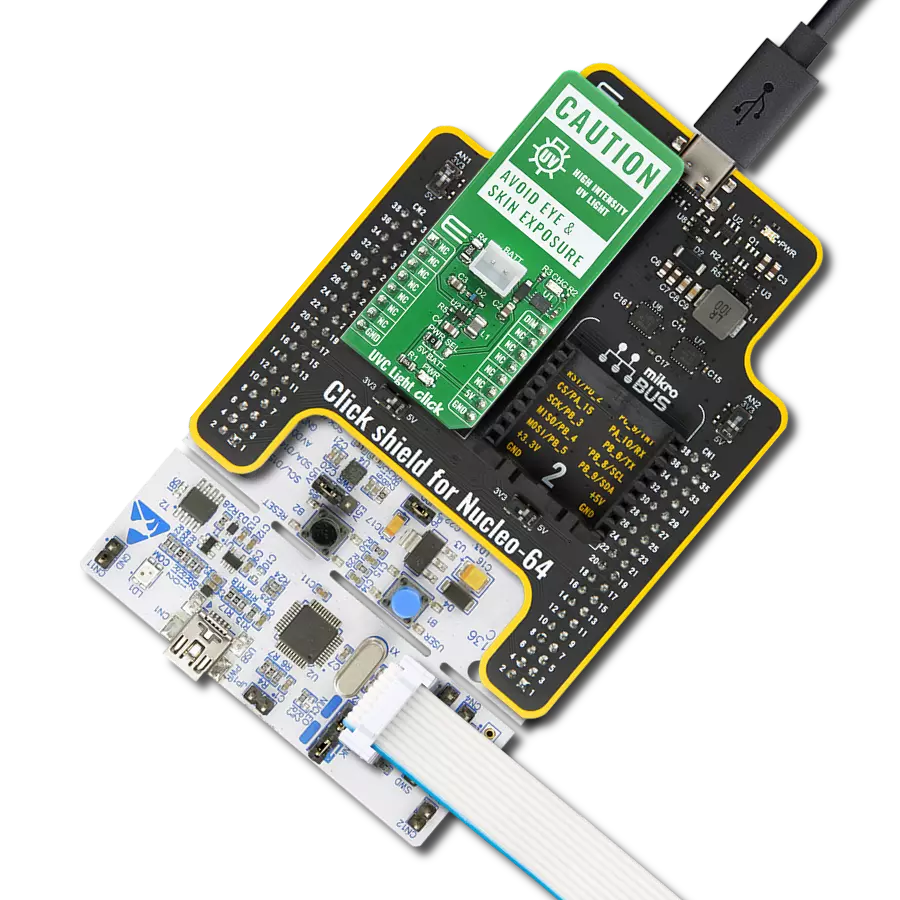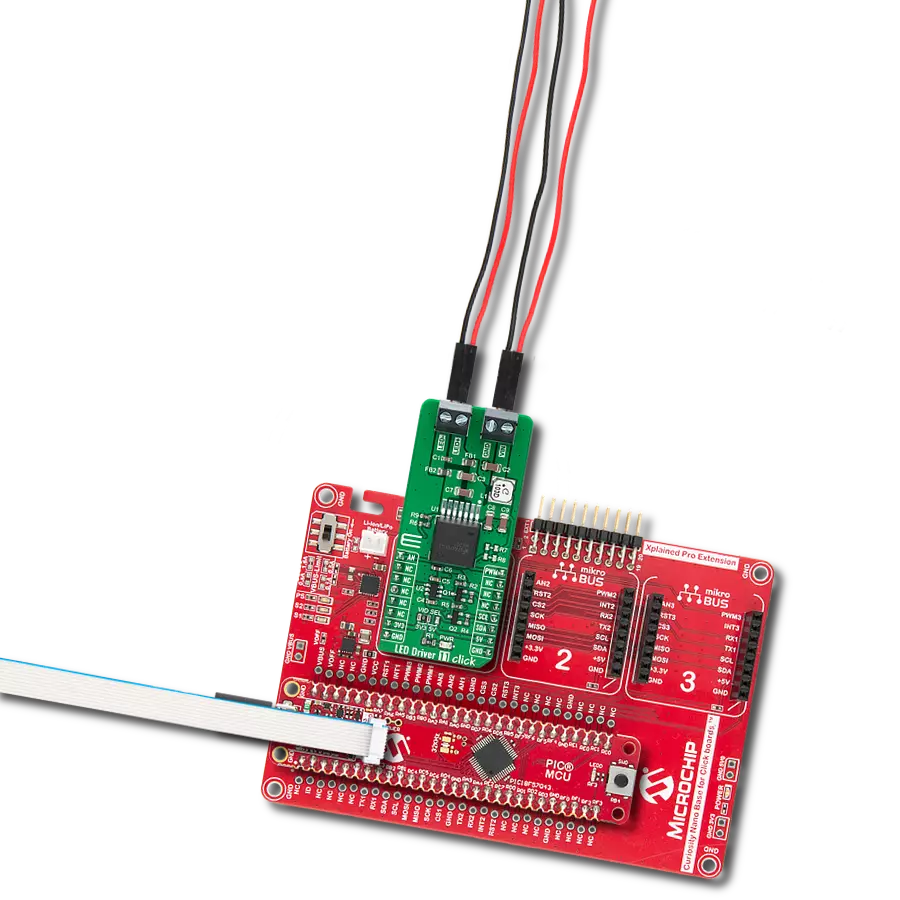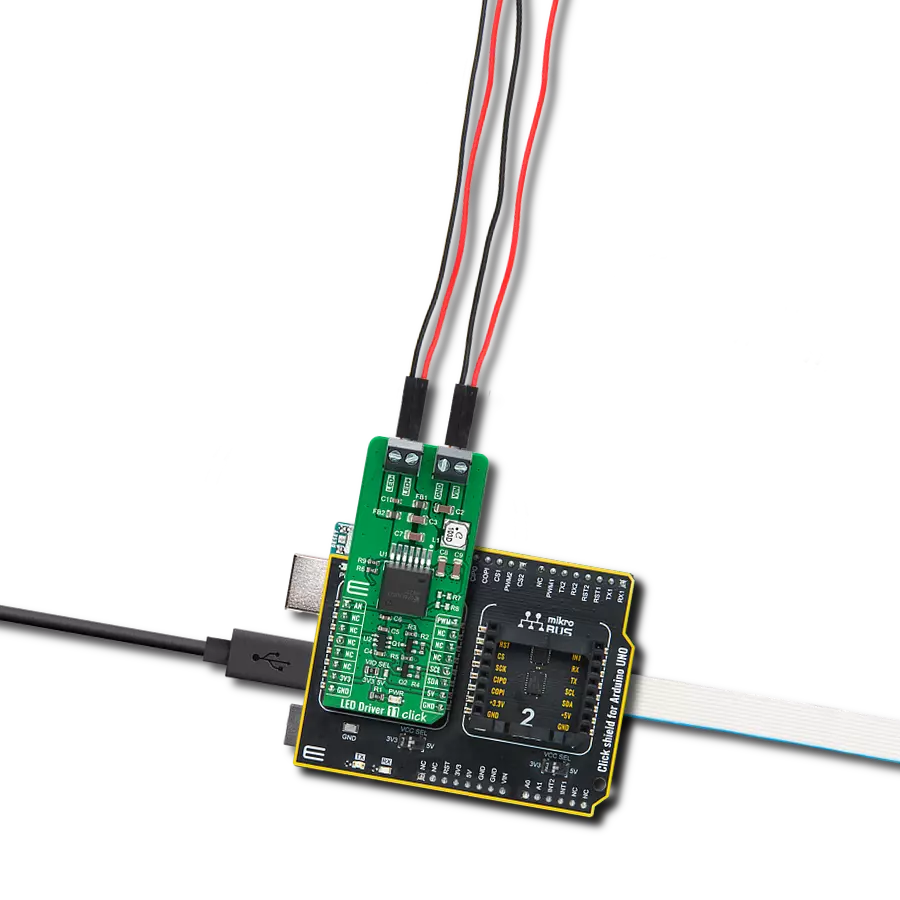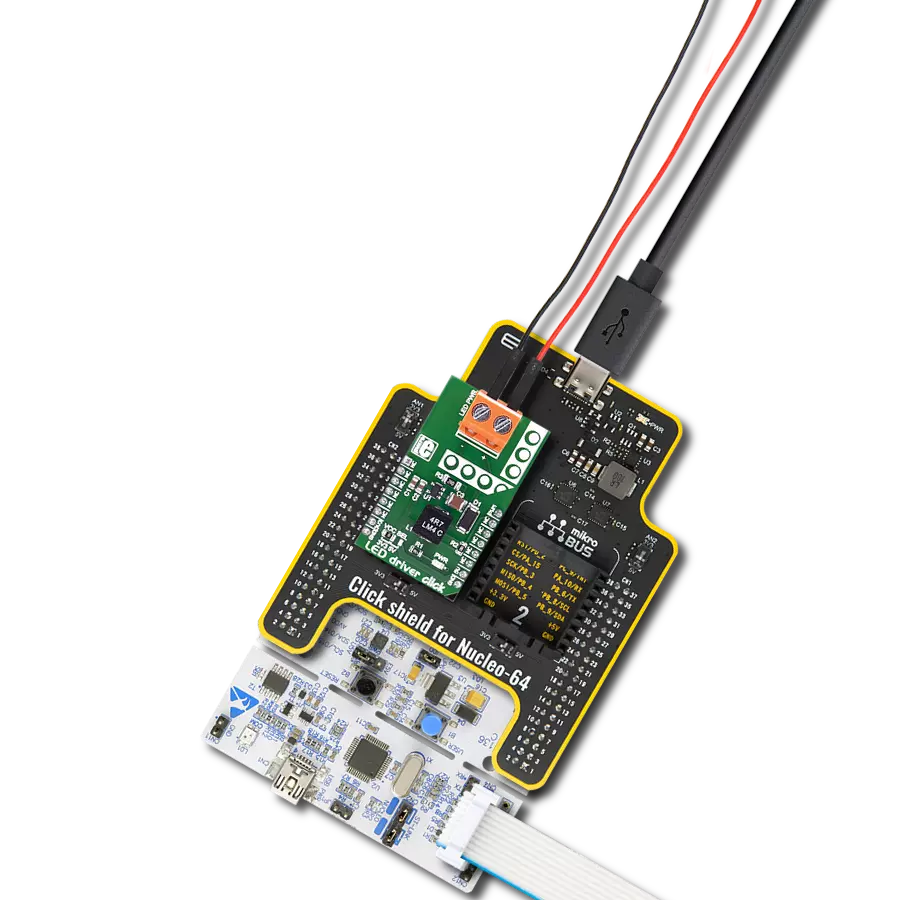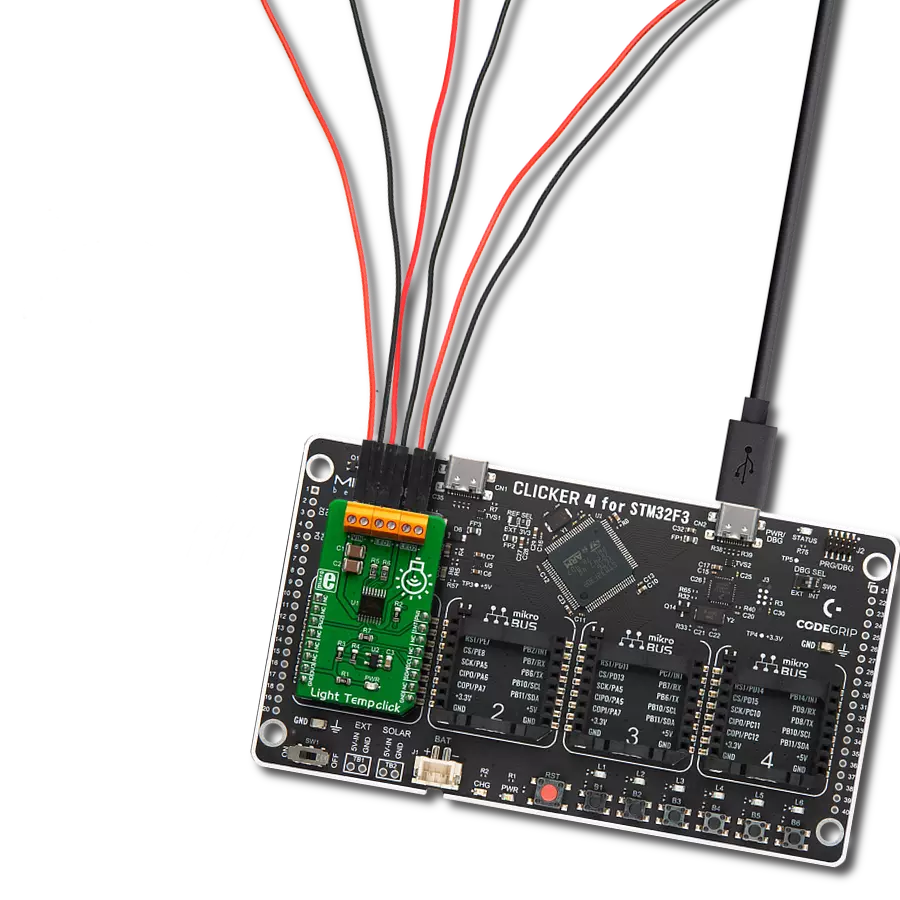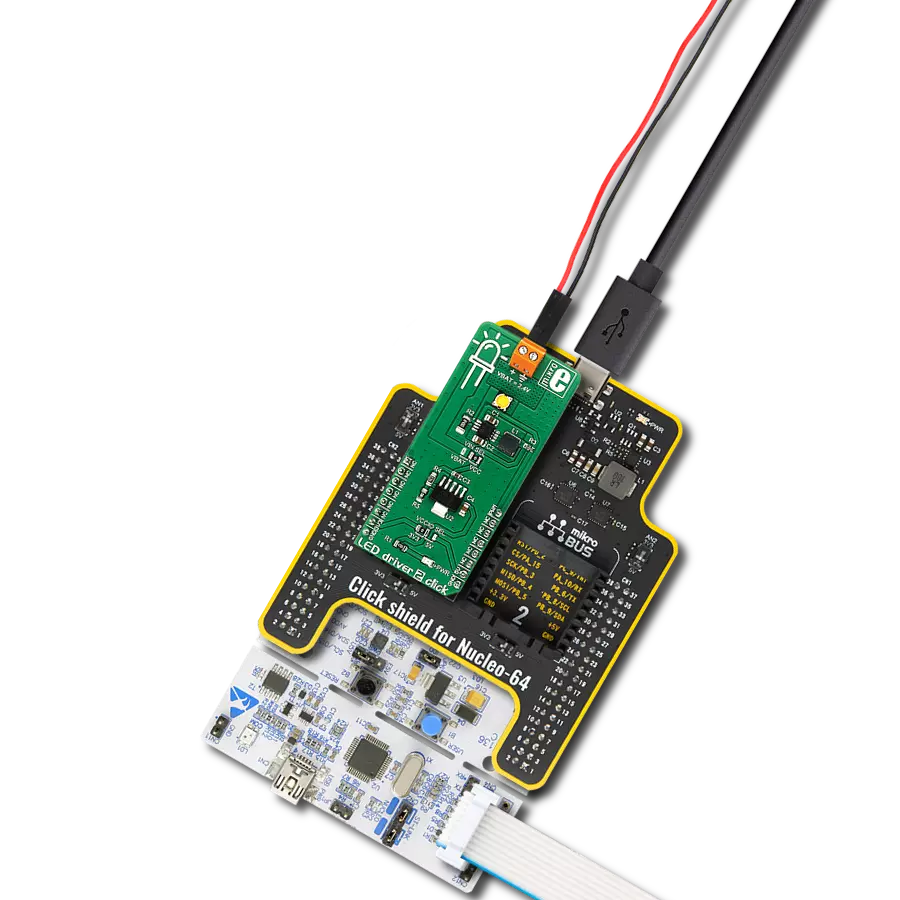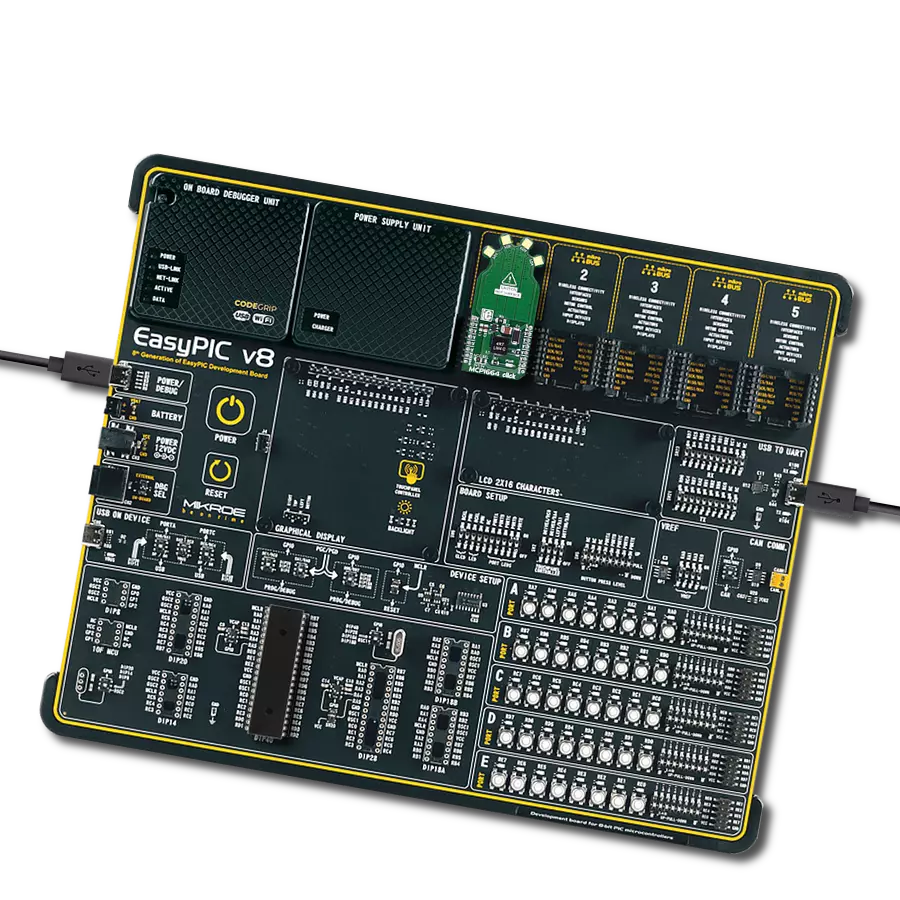Transform your lighting setups into masterpieces with our LED driver solution, offering effortless control for multiple LEDs, so you can focus on the brilliance of your designs
A
A
Hardware Overview
How does it work?
LED Driver 13 Click is based on the A80604-1, a multi-output LED driver for automotive applications designed at a switching frequency of 400kHz from Allegro Microsystems. The A80604-1 implements a current-mode boost/SEPIC converter with a gate driver for onboard external N-channel MOSFET. Thus, it provides an output current of 150mA per channel at an output voltage of approximately 26V, limited by the input voltage of the A80604-1, which must be in the range of 6V to 18V for proper operation. It also has integrated protection circuitry to guard against output short, overvoltage, LED short-circuits protections, and overtemperature. This Click board™ offers two ways to implement LED dimming: analog dimming via an onboard potentiometer or through an external PWM signal applied on the onboard header labeled as PWM and PWM dimming using a PWM pin from the mikroBUS™
socket. Using the patented Pre-Emptive Boost control, an LED brightness contrast ratio of 15,000:1 can be achieved using PWM dimming 200Hz. A higher ratio of 150,000:1 is possible using a combination of PWM and analog dimming. The analog dimming selection can be made by positioning the SMD jumper labeled ADIM SEL to an appropriate position marked as POT or PWM. The switching frequency of the A80604-1 can be externally synchronized to an external clock or generated internally - programmed between 260kHz and 2.3MHz. The spread-spectrum technique (with user-programmable dithering range and modulation frequency) is provided to reduce EMI. A clock-out signal, available on the onboard header labeled CLKO, allows other converters to be synchronized to the switching frequency of A80604-1. As mentioned in the product description, LED Driver 13 Click
communicates with MCU using several GPIO pins. The Enable pin, labeled as EN of the mikroBUS™ socket, optimizes power consumption used for power ON/OFF purposes of the board. In addition, it also uses a fault pin labeled as FLT and routed to the INT pin of the mikroBUS™ socket, which indicates the previously mentioned fault conditions to an external system if any fault occurs during operation. This fault signal is also visually indicated via a red LED labeled FAULT. Once the fault is removed, the soft-start process will continue. This Click board™ can operate with either 3.3V or 5V logic voltage levels selected via the VCC SEL jumper. This way, both 3.3V and 5V capable MCUs can use the communication lines properly. Also, this Click board™ comes equipped with a library containing easy-to-use functions and an example code that can be used as a reference for further development.
Features overview
Development board
Fusion for STM32 v8 is a development board specially designed for the needs of rapid development of embedded applications. It supports a wide range of microcontrollers, such as different 32-bit ARM® Cortex®-M based MCUs from STMicroelectronics, regardless of their number of pins, and a broad set of unique functions, such as the first-ever embedded debugger/programmer over WiFi. The development board is well organized and designed so that the end-user has all the necessary elements, such as switches, buttons, indicators, connectors, and others, in one place. Thanks to innovative manufacturing technology, Fusion for STM32 v8 provides a fluid and immersive working experience, allowing
access anywhere and under any circumstances at any time. Each part of the Fusion for STM32 v8 development board contains the components necessary for the most efficient operation of the same board. An advanced integrated CODEGRIP programmer/debugger module offers many valuable programming/debugging options, including support for JTAG, SWD, and SWO Trace (Single Wire Output)), and seamless integration with the Mikroe software environment. Besides, it also includes a clean and regulated power supply module for the development board. It can use a wide range of external power sources, including a battery, an external 12V power supply, and a power source via the USB Type-C (USB-C) connector.
Communication options such as USB-UART, USB HOST/DEVICE, CAN (on the MCU card, if supported), and Ethernet is also included. In addition, it also has the well-established mikroBUS™ standard, a standardized socket for the MCU card (SiBRAIN standard), and two display options for the TFT board line of products and character-based LCD. Fusion for STM32 v8 is an integral part of the Mikroe ecosystem for rapid development. Natively supported by Mikroe software tools, it covers many aspects of prototyping and development thanks to a considerable number of different Click boards™ (over a thousand boards), the number of which is growing every day.
Microcontroller Overview
MCU Card / MCU
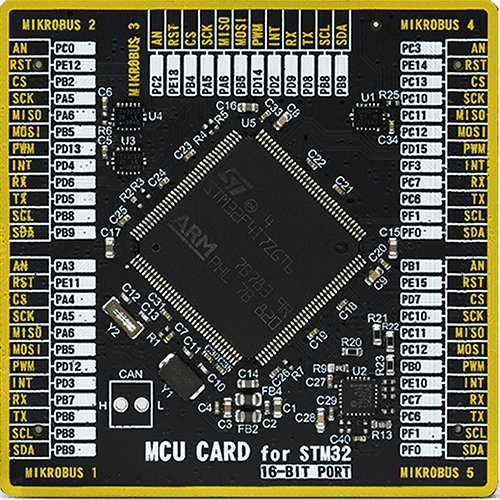
Type
8th Generation
Architecture
ARM Cortex-M4
MCU Memory (KB)
1024
Silicon Vendor
STMicroelectronics
Pin count
144
RAM (Bytes)
196608
Used MCU Pins
mikroBUS™ mapper
Take a closer look
Click board™ Schematic

Step by step
Project assembly
Track your results in real time
Application Output
1. Application Output - In Debug mode, the 'Application Output' window enables real-time data monitoring, offering direct insight into execution results. Ensure proper data display by configuring the environment correctly using the provided tutorial.

2. UART Terminal - Use the UART Terminal to monitor data transmission via a USB to UART converter, allowing direct communication between the Click board™ and your development system. Configure the baud rate and other serial settings according to your project's requirements to ensure proper functionality. For step-by-step setup instructions, refer to the provided tutorial.

3. Plot Output - The Plot feature offers a powerful way to visualize real-time sensor data, enabling trend analysis, debugging, and comparison of multiple data points. To set it up correctly, follow the provided tutorial, which includes a step-by-step example of using the Plot feature to display Click board™ readings. To use the Plot feature in your code, use the function: plot(*insert_graph_name*, variable_name);. This is a general format, and it is up to the user to replace 'insert_graph_name' with the actual graph name and 'variable_name' with the parameter to be displayed.

Software Support
Library Description
This library contains API for LED Driver 13 Click driver.
Key functions:
leddriver13_set_enable- LED Driver 13 set enable functionleddriver13_pwm_start- LED Driver 13 start PWM moduleleddriver13_set_duty_cycle- LED Driver 13 sets PWM duty cycle
Open Source
Code example
The complete application code and a ready-to-use project are available through the NECTO Studio Package Manager for direct installation in the NECTO Studio. The application code can also be found on the MIKROE GitHub account.
/*!
* @file main.c
* @brief LEDDriver13 Click example
*
* # Description
* This library contains API for LED Driver 13 Click driver.
*
* The demo application is composed of two sections :
*
* ## Application Init
* Initializes the driver and executes the Click default configuration which
* starts the PWM module and sets the LEDs current to minimum.
*
* ## Application Task
* This is an example that demonstrates the use of the LED Driver 13 Click board™.
* The app controls the LEDs brightness by changing the PWM duty cycle.
* The PWM duty cycle percentage will be logged on the USB UART.
*
* @author Nenad Filipovic
*
*/
#include "board.h"
#include "log.h"
#include "leddriver13.h"
static leddriver13_t leddriver13;
static log_t logger;
void application_init ( void )
{
log_cfg_t log_cfg; /**< Logger config object. */
leddriver13_cfg_t leddriver13_cfg; /**< Click config object. */
/**
* Logger initialization.
* Default baud rate: 115200
* Default log level: LOG_LEVEL_DEBUG
* @note If USB_UART_RX and USB_UART_TX
* are defined as HAL_PIN_NC, you will
* need to define them manually for log to work.
* See @b LOG_MAP_USB_UART macro definition for detailed explanation.
*/
LOG_MAP_USB_UART( log_cfg );
log_init( &logger, &log_cfg );
log_info( &logger, " Application Init " );
// Click initialization.
leddriver13_cfg_setup( &leddriver13_cfg );
LEDDRIVER13_MAP_MIKROBUS( leddriver13_cfg, MIKROBUS_1 );
if ( PWM_ERROR == leddriver13_init( &leddriver13, &leddriver13_cfg ) )
{
log_error( &logger, " Communication init." );
for ( ; ; );
}
if ( LEDDRIVER13_ERROR == leddriver13_default_cfg ( &leddriver13 ) )
{
log_error( &logger, " Default configuration." );
for ( ; ; );
}
log_info( &logger, " Application Task " );
leddriver13_set_duty_cycle ( &leddriver13, 0.01 );
Delay_ms ( 100 );
}
void application_task ( void )
{
static int8_t duty_cnt = 1;
static int8_t duty_inc = 1;
float duty = duty_cnt / 1000.0;
leddriver13_set_duty_cycle ( &leddriver13, duty );
log_printf( &logger, "> Duty: %.1f%%\r\n", duty * 100 );
Delay_ms ( 100 );
if ( 30 == duty_cnt )
{
duty_inc = -1;
}
else if ( 0 == duty_cnt )
{
duty_inc = 1;
}
duty_cnt += duty_inc;
}
int main ( void )
{
/* Do not remove this line or clock might not be set correctly. */
#ifdef PREINIT_SUPPORTED
preinit();
#endif
application_init( );
for ( ; ; )
{
application_task( );
}
return 0;
}
// ------------------------------------------------------------------------ END




















